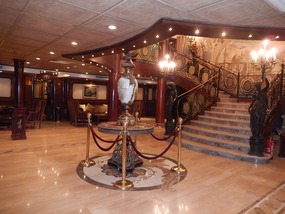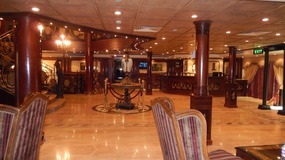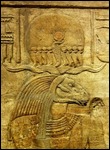September 19….Off to our cruise down the Nile
After our buffet breakfast at the hotel, we headed to the airport for our flight to Luxor, to begin our cruise on the Nile
. We were met by Mondoo, our guide, who took us to our river boat so we could drop off the luggage before going to the first site. The ship was ornate and quite luxurious, complete with a swimming pool and bar on the top deck. Our room was spacious and comfortable with a big window from which we could gaze out to the banks of the Nile as we sailed by and was great for taking photos.
Our guide, Mondoo, had his degree in Egyptology and was a walking history book. He told us that Luxor, as the site of the Ancient Egyptian city of Thebes, has frequently been characterized as the world's greatest open-air museum, with the ruins of the temple complexes of Karnak and Luxor located within the modern city. After we got settled in on the ship, we drove to this ancient religious site which, after Angkor Wat in Cambodia, is the second largest in the world, and was the main place of worship of the eighteenth dynasty with the god Amun as its head.
The key difference between Karnak and most other temples and sites in Egypt is that it was in a constant state of construction and deconstruction with approximately thirty pharaohs contributing to the buildings, enabling it to reach a size, complexity, and diversity not seen elsewhere
. The deities represented range from some of the earliest worshiped to those worshiped much later in the history of the Ancient Egyptian culture as almost every king of the Middle Kingdom left some mark of his presence at Karnak.
As we approached the gateway to this ancient Eqyptian Temple, we passed an impressive avenue of ram-headed sphinxes, symbolizing the god Amun and a small effigy of Ramesses II, in the form of the god Osiris, standing between the front paws of each sphinx. Upon entering, we encountered the famous aspect of Karnak, the Hypostyle Hall, which covers an area of 5,000 sq meters with 134 massive columns arranged in 16 rows. 122 of the columns are 10 meters tall and the other 12 are 21 meters tall with a diameter of over three meters. The architraves…the main beam resting across the tops of the columns…are estimated to weigh 70 tons and have sparked numerous theories as to how they could possibly have been lifted to these heights, one theory being that they were towed up stone rafts
. Hypostyle Hall is the largest pillared hall in Egypt and among the largest in the world.
As we walked through the ruins, much of it very well preserved, Mondoo gave us detailed information about the meaning of the hieroglyphics and the images of the various gods that covered the walls and the columns and explained the positioning and significance of the hundreds of massive statues It was a humbling experience seeing this monumental Temple complex that dates back 5,200 years. It’s almost impossible to believe that something that old can still be standing.
Next, Mondoo showed us another engineering marvel….a 97 feet tall obelisk, weighing approximately 320 tons. This obelisk is the only one still standing of the four that were erected by Queen Hatshepsut, the fifth pharaoh of the Eighteenth Dynasty of Egypt and is the tallest surviving ancient obelisk on Earth. An inscription at its base indicates that the work of cutting the monolith out of the quarry required seven months of labor
. The Egyptian obelisks were always carved from single pieces of stone, usually pink granite from the distant quarries at Aswan, but exactly how they were transported hundreds of miles and then erected remains a mystery.
Next, we made the short drive to the temple complex of Luxor. An avenue of human headed sphinxes of over one and a half miles once connected the temples of Karnak and Luxor. Thas grand avenue was used, once a year, during the Opet festival when the Egyptians paraded along it carrying the statues of Amun and Mut in a symbolic re-enactment of their marriage. So far, the remains of 850 have been found but archaeologists think there were, originally, around 1,350 sphinx statues that lined this road, the construction of which began during the New Kingdom and finished during the 30th Dynasty.
Unlike the other temples in Karnak, Luxor temple is not dedicated to a cult god or a deified version of the king in death. Instead, Luxor temple is dedicated to the rejuvenation of kingship and may have been where many of the kings of Egypt were crowned in reality or conceptually, as in the case of Alexander the Great. During the Roman era, the temple and its surroundings were a legionary fortress and the home of the Roman government in the area. In addition, Luxor was never enhanced by different pharaohs throughout the ages so is lacking the grandeur that we saw at the Temple Complex of Karnak. Nevertheless, perusing the ruins of both complexes and realizing how incredibly ancient everything that we saw is, was an amazing thing to experience.
After our tour of Karnak and Luxor, we returned to our river boat to enjoy the upper pool and bar deck and fill up on the beautiful dinner buffet. We would be starting our cruise down the Nile after visiting the Valley of the Kings in the morning
OUR NILE EXCURSION CONTINUES
Monday, September 19, 2016
 Luxor, Luxor, Egypt
Luxor, Luxor, Egypt
Other Entries
-
29NOW WE'RE IN ROMANIA...WE SURE GET AROUND
Aug 2624 days prior Brasov, Romaniaphoto_camera22videocam 0comment 4
Brasov, Romaniaphoto_camera22videocam 0comment 4 -
30WALKING TOUR IN BRASOV
Aug 2723 days prior Brasov, Romaniaphoto_camera18videocam 0comment 0
Brasov, Romaniaphoto_camera18videocam 0comment 0 -
31ALL I CAN SAY IS.....BIZARRE
Aug 2822 days prior Sacele, Romaniaphoto_camera18videocam 0comment 2
Sacele, Romaniaphoto_camera18videocam 0comment 2 -
32PHOTO JOURNAL OF OUR SACELE HOME EXCHANGE
Aug 2921 days prior Săcele, Romaniaphoto_camera18videocam 0comment 5
Săcele, Romaniaphoto_camera18videocam 0comment 5 -
33VISITING THE LOVELY TOWN OF SINAIA
Aug 3020 days prior Sinaia, Romaniaphoto_camera26videocam 0comment 1
Sinaia, Romaniaphoto_camera26videocam 0comment 1 -
34OCTOBERFEST, SIGHISOARA THEN THE BLACK SEA
Aug 3119 days prior Sighisoara, Romaniaphoto_camera39videocam 0comment 3
Sighisoara, Romaniaphoto_camera39videocam 0comment 3 -
35ANOTHER COUNTRY, ANOTHER HOME EXCHANGE
Sep 0217 days prior Kosharitsa, Bulgariaphoto_camera29videocam 0comment 2
Kosharitsa, Bulgariaphoto_camera29videocam 0comment 2 -
36THE ENCHANTING VILLAGE OF SOZOPOL
Sep 0415 days prior Sozopol, Bulgariaphoto_camera34videocam 0comment 4
Sozopol, Bulgariaphoto_camera34videocam 0comment 4 -
37WE'RE ON OUR OWN
Sep 0613 days prior Sveti Vlas, Bulgariaphoto_camera12videocam 0comment 2
Sveti Vlas, Bulgariaphoto_camera12videocam 0comment 2 -
38LAST FEW DAYS IN EASTERN EUROPE
Sep 0712 days prior Sveti Vlas, Bulgariaphoto_camera21videocam 0comment 6
Sveti Vlas, Bulgariaphoto_camera21videocam 0comment 6 -
39MYSTERY OF THE MISSING LUGGAGE
Sep 109 days prior Istanbul, Turkeyphoto_camera5videocam 0comment 1
Istanbul, Turkeyphoto_camera5videocam 0comment 1 -
40SENSORY OVERLOAD
Sep 118 days prior Istanbul, Turkeyphoto_camera31videocam 0comment 9
Istanbul, Turkeyphoto_camera31videocam 0comment 9 -
41TAKSIM SQUARE AND THE POTATO SEARCH
Sep 127 days prior Istanbul, Turkeyphoto_camera34videocam 0comment 3
Istanbul, Turkeyphoto_camera34videocam 0comment 3 -
42MAYBE THIS IS WHAT IT LOOKS LIKE ON THE MOON
Sep 136 days prior Nevsehir, Turkeyphoto_camera29videocam 1comment 6
Nevsehir, Turkeyphoto_camera29videocam 1comment 6 -
43DAY TWO - CAPPADOCIA
Sep 145 days prior Nevsehir, Turkeyphoto_camera32videocam 0comment 5
Nevsehir, Turkeyphoto_camera32videocam 0comment 5 -
44LAST TWO DAYS IN ISTANBUL
Sep 154 days prior Istanbul, Turkeyphoto_camera29videocam 0comment 3
Istanbul, Turkeyphoto_camera29videocam 0comment 3 -
45CAIRO AND OUR FABULOUS NILE RIVER CRUISE
Sep 172 days prior Cairo, Egyptphoto_camera24videocam 0comment 5
Cairo, Egyptphoto_camera24videocam 0comment 5 -
46OUR NILE EXCURSION CONTINUES
Sep 19 Luxor, Egyptphoto_camera35videocam 0comment 6
Luxor, Egyptphoto_camera35videocam 0comment 6 -
47VALLEY OF THE KINGS
Sep 201 day later Luxor, Egyptphoto_camera34videocam 0comment 8
Luxor, Egyptphoto_camera34videocam 0comment 8 -
48EDFU AND KOM OMBO
Sep 212 days later Aswān, Egyptphoto_camera36videocam 0comment 5
Aswān, Egyptphoto_camera36videocam 0comment 5 -
49OUR LAST FULL DAY ON THE NILE EXCURSION
Sep 223 days later Aswān, Egyptphoto_camera32videocam 0comment 4
Aswān, Egyptphoto_camera32videocam 0comment 4 -
50THE AIRPORT FIASCO
Sep 234 days later Addis Ababa, Ethiopiaphoto_camera23videocam 0comment 4
Addis Ababa, Ethiopiaphoto_camera23videocam 0comment 4 -
51THE MESKEL FESTIVAL
Sep 267 days later Addis Ababa, Ethiopiaphoto_camera29videocam 4comment 1
Addis Ababa, Ethiopiaphoto_camera29videocam 4comment 1 -
52THE ASTOUNDING CHURCHES OF LALIBELA
Sep 289 days later Lalibela, Ethiopiaphoto_camera42videocam 0comment 2
Lalibela, Ethiopiaphoto_camera42videocam 0comment 2 -
53OUR NEW SON
Sep 2910 days later Lalibela, Ethiopiaphoto_camera39videocam 1comment 4
Lalibela, Ethiopiaphoto_camera39videocam 1comment 4 -
54BACK TO ADDIS ABABA
Sep 3011 days later Addis Ababa, Ethiopiaphoto_camera30videocam 3comment 2
Addis Ababa, Ethiopiaphoto_camera30videocam 3comment 2 -
55FINALLY.....THE ANIMALS!!!!
Oct 0314 days later Nairobi, Kenyaphoto_camera51videocam 2comment 6
Nairobi, Kenyaphoto_camera51videocam 2comment 6 -
56MORE SAFARI THEN BACK TO NAIROBI
Oct 06382 days later Lake Nakuru National Park, Kenyaphoto_camera35videocam 0comment 1
Lake Nakuru National Park, Kenyaphoto_camera35videocam 0comment 1 -
57FABULOUS HOME EXCHANGE IN DEBASO, KENYA
Oct 09385 days later Malindi, Kenyaphoto_camera29videocam 0comment 5
Malindi, Kenyaphoto_camera29videocam 0comment 5 -
58UNWINDING IN PARADISE
Oct 10386 days later Watamu, Kenyaphoto_camera25videocam 0comment 3
Watamu, Kenyaphoto_camera25videocam 0comment 3 -
59THE GEDI RUINS
Oct 12388 days later Gede, Kenyaphoto_camera12videocam 0comment 0
Gede, Kenyaphoto_camera12videocam 0comment 0
Comments
2025-05-22
Comment code: Ask author if the code is blank

 Luxor, Luxor, Egypt
Luxor, Luxor, Egypt








































Whitey
2016-11-15
Egypt is the best! Enjoy it while we sort things out at home.
Phyllis
2016-11-15
Wow! You are right. I would have loved this part of your trip. Amazing
Pastricks
2016-11-15
Wow! Great history lesson. Photos outstanding. Hugs
Dave Colson
2016-11-15
Wow..!!